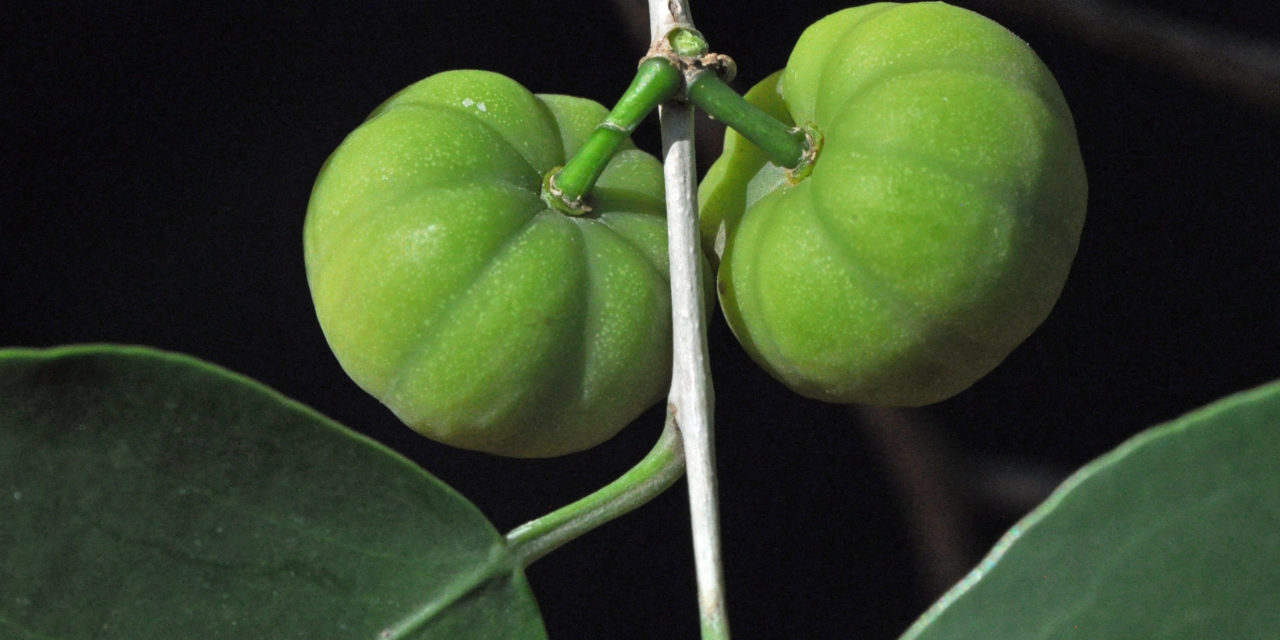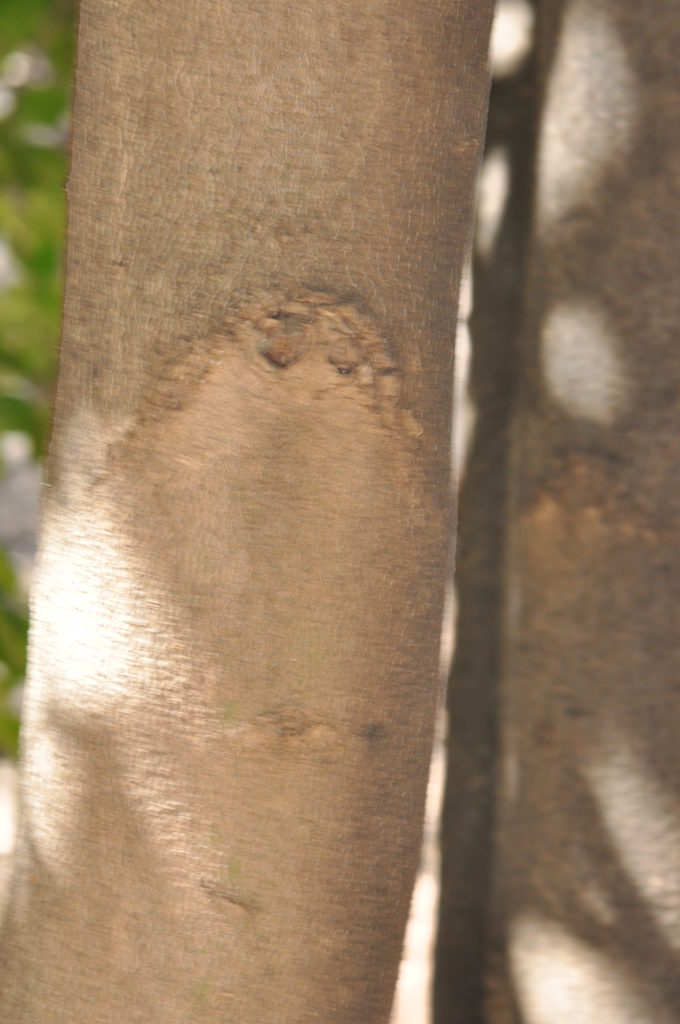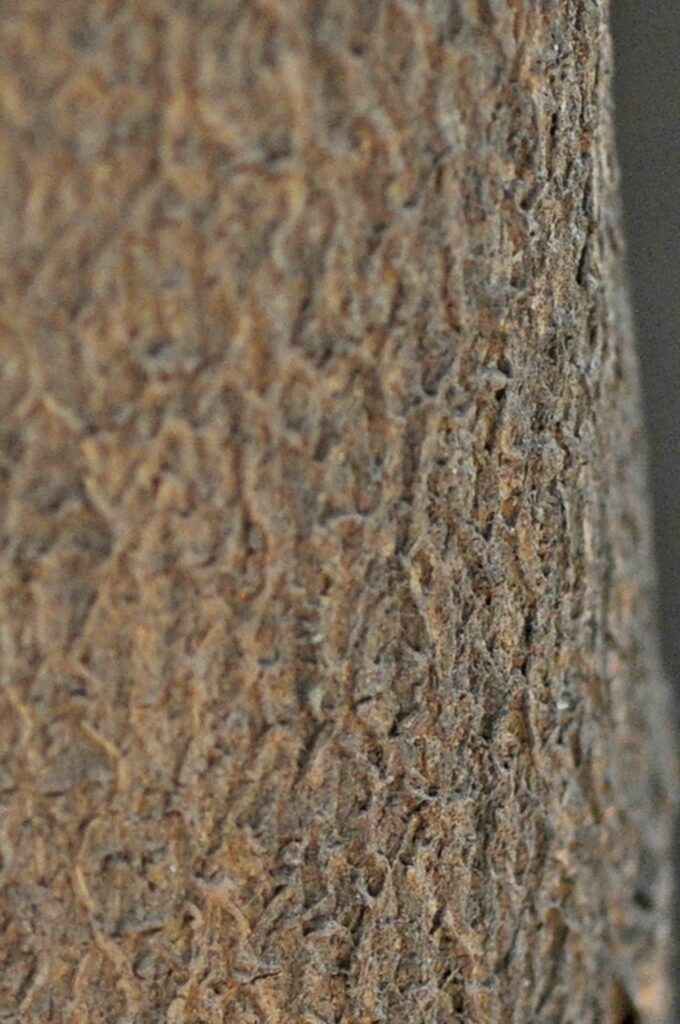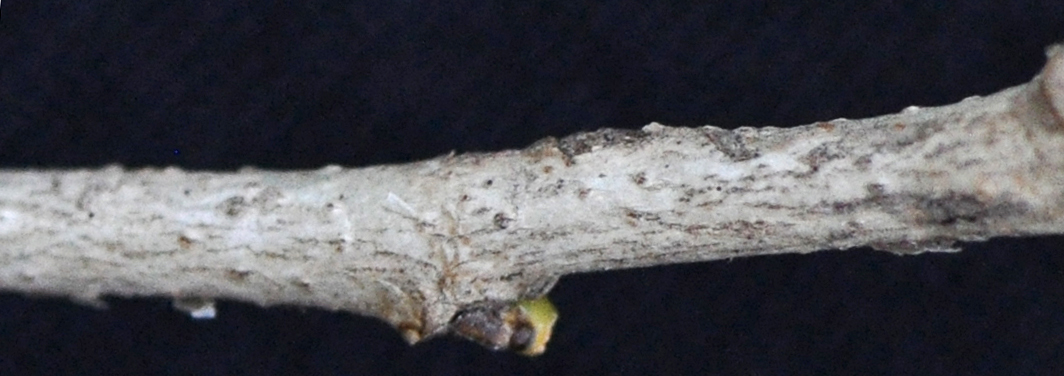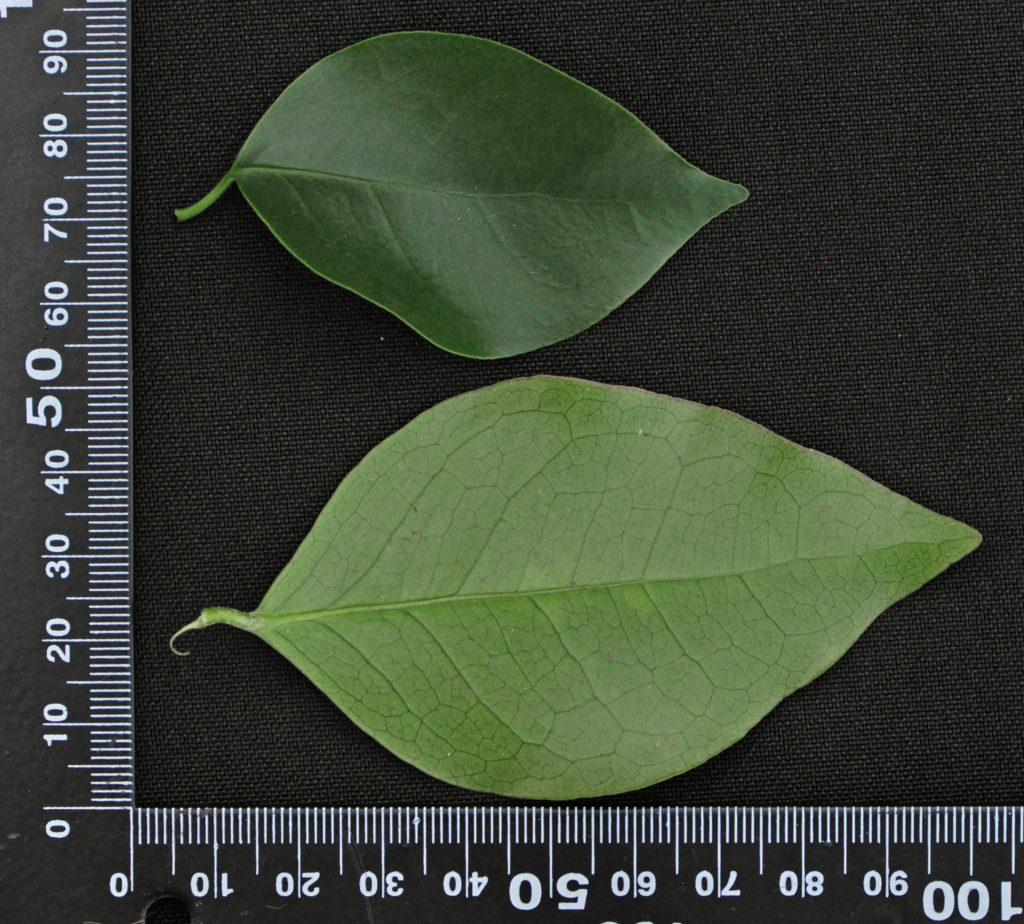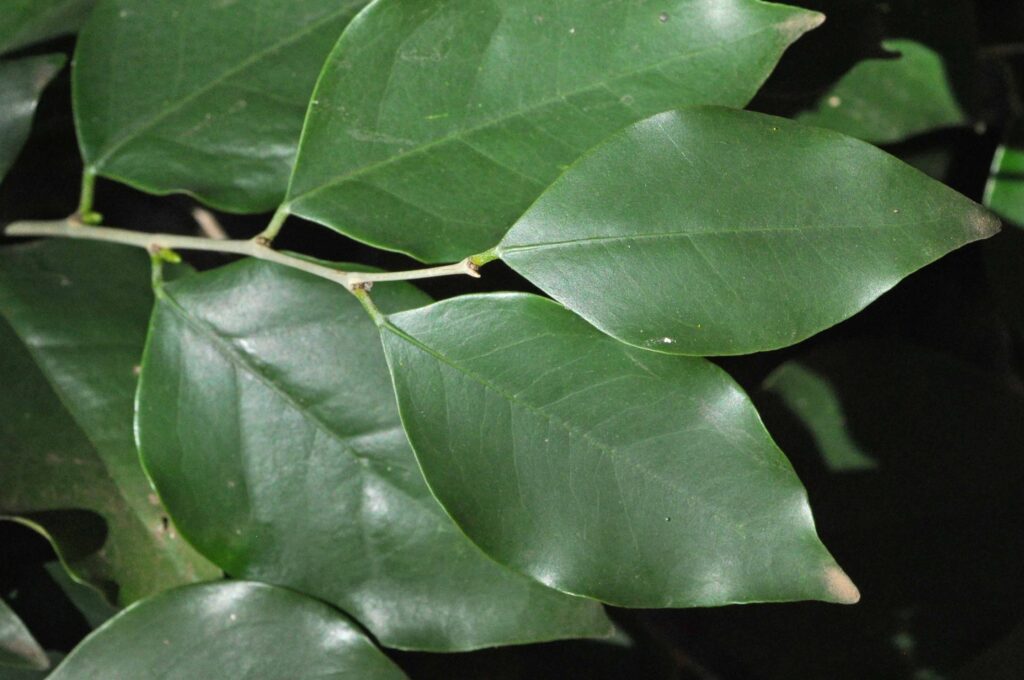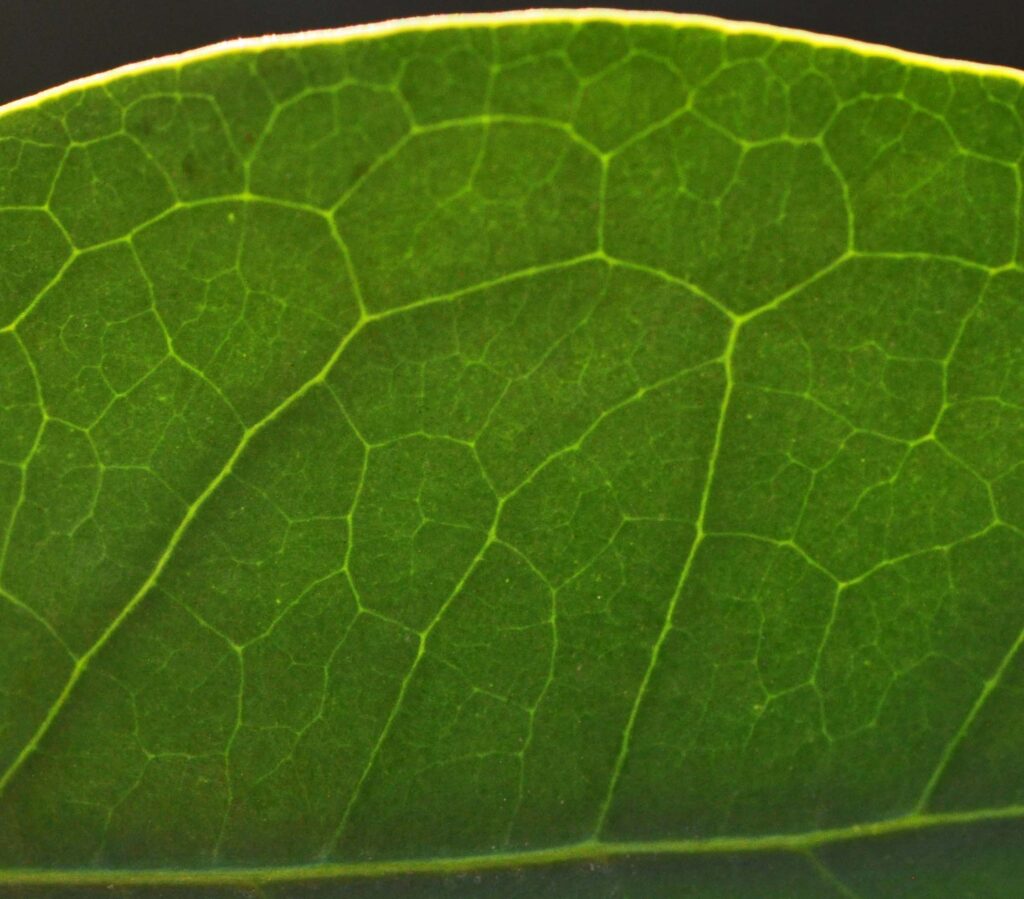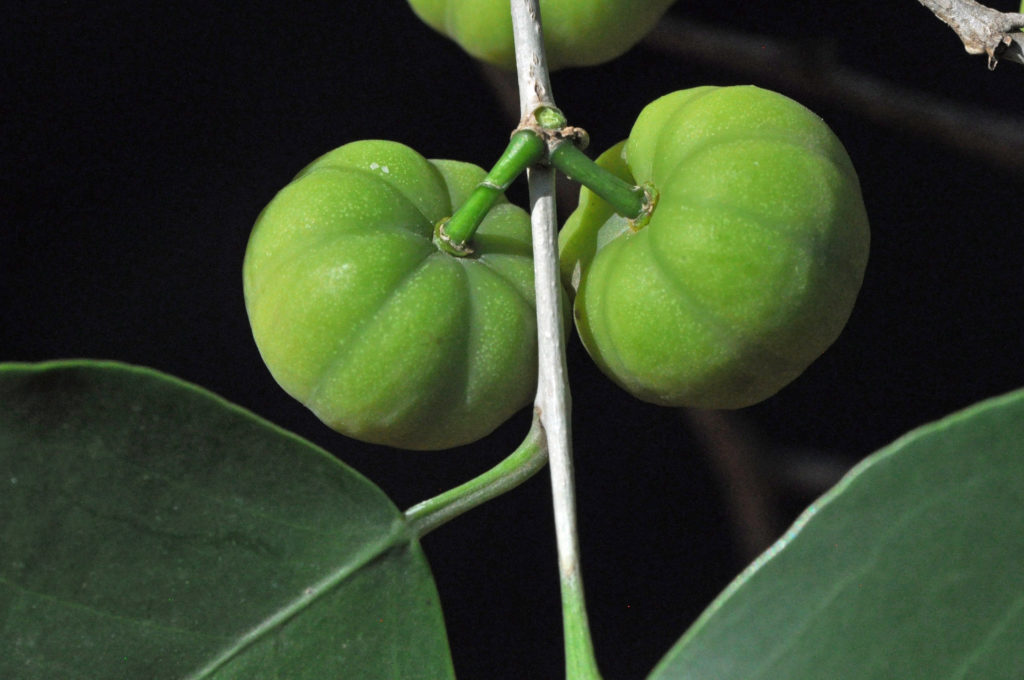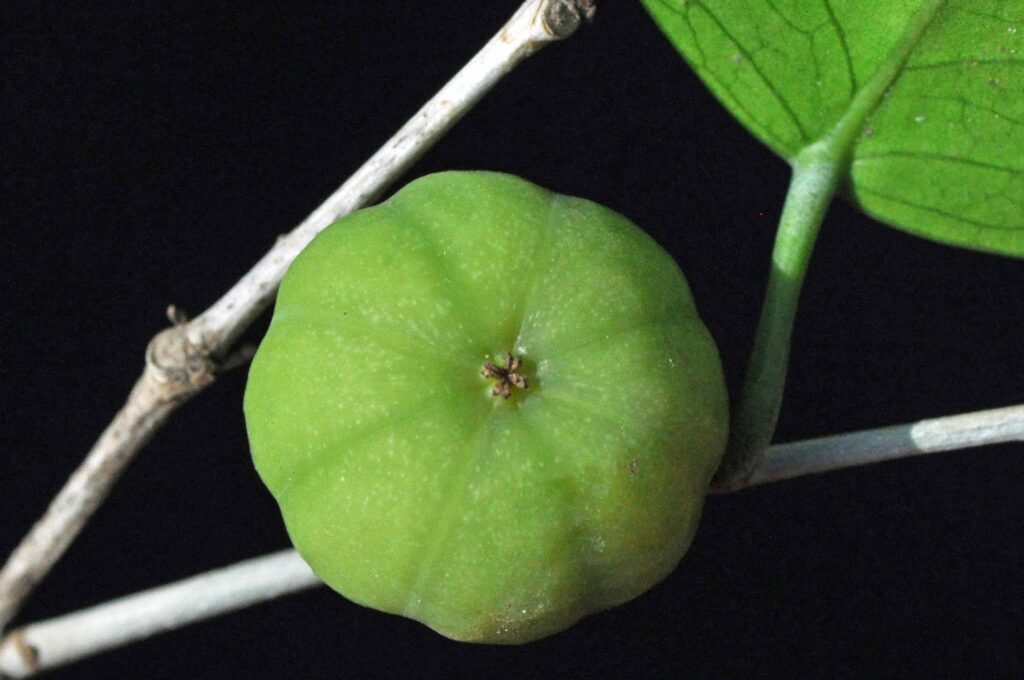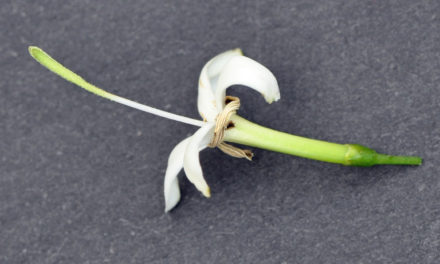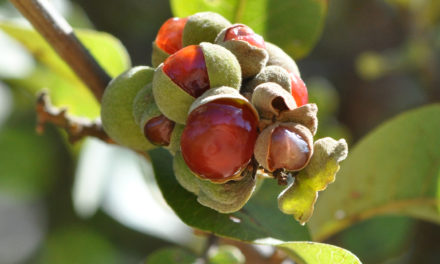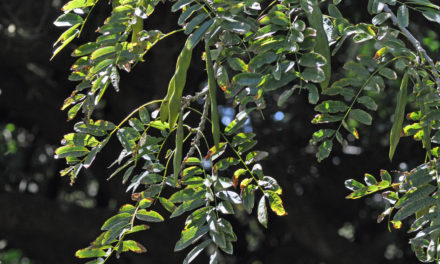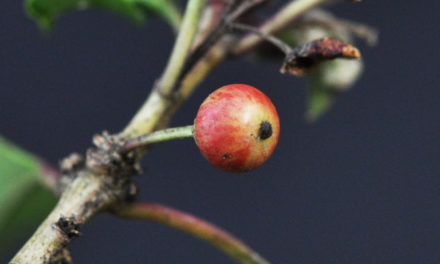General Info – summary
This latex free glabrous dioecious Tree is up to 30m high. Trees give a dense shade. The simple, hairless, entire, alternate & shiny Leaves have entire margins & lack stipules. The minute, greenish, regular Flowers are in cymes. Male with 8-12 stamens. Female with a superior ovary with 4-5 sessile, bilobed stigmas. Fruit is an explosive, locular capsule releasing small brown seeds with a papery endosperm.
Description
Heywoodia lucens
SA Tree No. 306.
Common names: (Afr) Ebbehout, Stinkebbehout, Stink-ebbehout, Swartebbehout, Swart-ebbehout, Swartebbenhout. (Eng) Black Ebony, Cape Ebony, Foetid-ebony, Stink Ebony. (isiXhosa) Umnebelele. (isiZulu) Ibeyana, Umnebelele. (siSwati) Umndebelele.
Family: Phyllanthaceae. In this diverse family, Latex and Spines are usually absent. This is diagnostic and excludes them from Euphorbiaceae. There are about 50+ genera and 2 000 species in this family. They are most numerous in the tropics and most members are trees. Leaves are usually simple, alternate and petiolate. Leaf margins are usually entire and, leaves are present in most species. The actinomorphic Flowers are usually unisexual and may be monoecious or dioecious. The superior Ovary has 2 ovules in each locule. The Fruit is a berry, drupe or schizocarp. Local genera containing trees on this website include Antidesma, Bridelia, Cleistanthus and Heywoodia.
Name derivation: Heywoodia – after A. W. Heywood – author of Cape Woods and Forests. He was the conservator of forests in the Eastern Cape -1901. lucens – shiny – refers to the shiny leaves. lucens is the only species in the genus Heywoodia.
Conservation: National Status: L. C. (Least Concern). Assessment: 2005 (R.H. Archer and J.E. Victor).
Tree
This glabrous (hairless) and spineless, high branching Tree is latex free with a trunk that may reach nearly 1m wide and up to 30m high (usually less). Bark is pale grey-brown (photo 432) to silver-green (photo 935) and becomes slightly rough in older trees (photo 432). It may flake in thin, patchy pieces. Young branches are 4-angled but become terete (circular in cross-section) and have light coloured lenticels (usually raised corky oval or elongated areas on the plant that allows the uncontrolled interchange of gases with the environment – photo 935).
- 564. 2017/10/17. Pretoria NBG. Photo: David Becking.
- 432. 2018/08/29. Pretoria NBG. Photo: David Becking.
- 935. 2017/11/14. Pretoria NBG. Photo: David Becking.
Leaves
The Petiole (leaf stalk – photo 937) is up to 2cm long and grooved on the upper surface (photo 342 – under Fruit). Young evergreen Leaves and those on coppice growth are peltate (in a more or less circular leaf, the petiole is attached at a point on the underside). In hairless, mature leaves, the petiole is closer to the leaf base making the peltate function less obvious (photo 344 under Fruit). Leaves become ovate (egg shaped) to lanceolate and are alternate and simple (have a single blade, which may have incisions that are not deep enough to divide the leaf into leaflets – photo 563). The adult tree has a Crown of dense, leathery Leaves. Each leaf is up to 13 x 8cm. The upper side is a shiny dark green (photo 563) and the lower side is much lighter (photo 937). Here the 8-12 Side veins are more visible. They loop and loop again before reaching the Margin (photo 436) which may be wavy (photo 563) and is entire (with a continuous margin, not in any way indented). Vein details are best seen when the leaf is viewed against a strong light (photo 436). The Midrib (the main rib of a leaf or leaf-like part, a continuation of, but excluding the petiole – photo 937) is distinct. The Apex is often attenuate (showing a long gradual taper) or may taper to a drip-tip. The rounded Base may be broadly tapering. In young leaves and those on coppice growth (when stems are cut or burned it causes regrowth from the stump or roots), the base may be shield shaped. Stipules (basal appendages of the petiole) are absent.
- 937. 2017/11/14. Pretoria NBG. Photo: David Becking.
- 563. 2017/10/17. Pretoria NBG. Photo: David Becking.
- 436. 2018/08/29. Pretoria NBG. Photo: David Becking.
Flowers
This tree is dioecious (unisexual floral structures with male and female parts on separate plants). The small, greenish yellow Flowers are short lasting. These inconspicuous flowers are located in axillary heads. In both male and female flowers there are 3 unequal ciliolate (having cilia – minute hair like) Sepals that are imbricate (having regularly arranged, overlapping edges, as roof tiles). The 5 elliptic-oblong membranous Petals are vertically wavy, fleshy and larger than the sepals. They are slightly erose (having the margin irregularly notched). The membranous disc (a more or less fleshy or elevated development of the receptacle) is 0,75mm wide and cupular (shaped like a small inverted cup). The almost sessile and more numerous Male Flowers develop in a compact Cyme (a broad, more or less flat-topped, determinate flower cluster, with central flowers opening first). They are borne in dense clusters. The 8-12 Stamens are up to 3mm long and occur in 2 whorls that are inserted inside the disc. The outer whorl of stamens is free and the inner ones are connate (joined) at the base. The somewhat distinct Anthers have 2-theca (with 2 pollen sacs). They produce microspores – pollen grains in seed plants). Here the ovary is rudimentary. The Female tree has more flowers. Each tiny Female flower is in a leaf axil and has a short (to 5mm long) pedicel (stalk of a single flower). These flowers lack stamens and may be solitary. The superior Ovary has 4-5 locules (compartments) with 2 ovules in each locule. There are 4-5 sessile, bilobed Stigmas (the end part of the pistil that receives the pollen). (Jul-Oct).
Fruit
Here each Pedicel (having a single stalk per flower/fruit) is up to 1cm long (photo 342). The fleshy and more or less spherical Fruit is up to 1,5 x 1cm. It is a locular Capsule (a dry fruit resulting from the maturing of a compound ovary that usually opens at maturity by one or more lines of dehiscence). The ripe 4 locular fruit contains 8-10 ridges (photo 344) which become wrinkled when dry. Eventually only 1 seed develops in each locule. This is because the second ovule aborts. The capsule dehisces explosively while still on the tree. Many capsules may be simultaneously present on the tree at various stages of development. The narrow oblong, smooth and shiny, often parasitized, Seeds are slightly triangular, brown and small – up to 8 x 6mm and have an attached fleshy structure. The embryo is minute and the 2 cotyledons (seed leaf; primary leaf or leaves in the embryo) are broad and flat. A papery endosperm (the starch and oil-containing tissue of many seeds; often referred to as the albumen) is present. (Nov. to all year).
- 342. 2018/01/16. Pretoria NBG. Photo: David Becking.
- 344. 2018/01/16. Pretoria NBG. Photo: David Becking.
Distribution & Ecology
These Trees are often gregarious (of plants growing in open clusters or in pure associations). The concentration of trees may be influenced by their explosive dispersal mechanism. They grow in coastal and scarp forests (scarp – a steep slope in the land that cuts across the underlying strata). Trees are located in the Eastern Cape e.g., around Port St Johns and southern KwaZulu Natal. Outside South Africa, trees occur in Swaziland, southern Mozambique in the Lebombo Mountains, and much further north to Kenya, Uganda, and Tanzania. Trees are often associated with termite mounds. These trees are more common on south-facing slopes and in evergreen forests and mainly occur from 1 100 to 1 800m. Trees provides a dense shade, which effectively cuts out access to light – preventing many other shorter plants from developing.
Ethnobotany
Air-dried Wood is used for building. It is strong, close grained and has a relatively high density: between 0,81 and 0,9 grams per cubic cm. When the density of any wood is greater than 1g per cubic cm, that wood will sink in fresh water. The heartwood is almost black and produces good purple-black sticks. This wood, together with Podocarpus species and other indigenous trees, was successfully used to make violins. From this wood, chin rests, fingerboards, frog pegs and tail pieces were made. The heartwood exudes a fetid smell. This is where the name “stink-ebony” originates. The Bark and Roots are used in local medicine.
References
Archer, R.H. & Victor, J.E. 2005. Heywoodia lucens Sim. National Assessment: Red List of South African Plants version 2020.1. Accessed on 2023/07/19.
Boon, R. 2010. Pooley’s Trees of eastern South Africa. Flora and Fauna Publications Trust, Durban.
Burrows, J.E., Burrows, S.M., Lotter, M.C. & Schmidt, E. 2018. Trees and Shrubs Mozambique. Publishing Print Matters (Pty) Ltd. Noordhoek, Cape Town.
Coates Palgrave, M. 2002. Keith Coates Palgrave Trees of Southern Africa, edn 3. Struik, Cape Town.
Lawrence, G. H. M, 1951. Taxonomy of Vascular Plants. The Macmillan Company, New York. Tenth Printing 1965.
Palmer, E. & Pitman, N. 1972. Trees of southern Africa. Balkema, Amsterdam, Cape Town.
van Wyk, B. & van Wyk, P. 1997 Field guide to Trees of Southern Africa. Struik, Cape Town.
https://en.wikipedia.org/wiki/Heywoodia
http://www.worldagroforestry.org/treesnmarkets/wood/data.php?id=1#
https://sun.gardenexplorer.org/taxon-360.aspx
https://en.wikipedia.org/wiki/Phyllanthaceae

